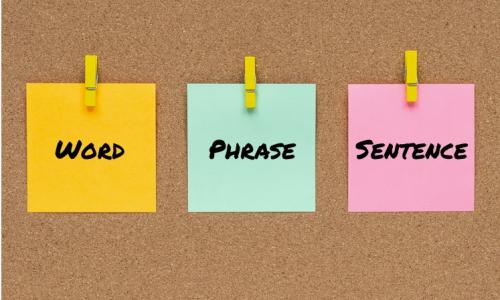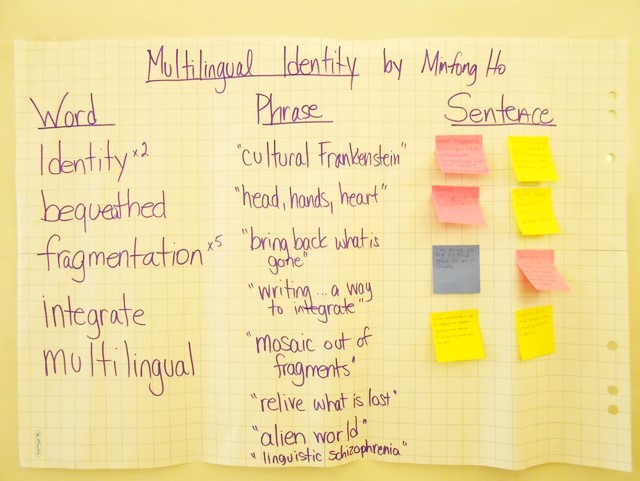Word-Phrase-Sentence

Word-Phrase-Sentence is a visible thinking routine from Harvard Project Zero that engages Grade 2-12 students with making meaning of text by discussing the importance of different words, phrases, and sentences. This strategy is part of Colorin Colorado's ELL Strategy Library and can be used to support academic language development for all students.
Strategy Overview
How This Strategy Supports Language Development
Even as multilingual learners develop the foundational reading skills necessary for decoding the words on the page, they still may not comprehend the text. The word-phrase-sentence routine focuses on meaning making at every stage. When students choose a single word that captured their attention, they justify why that word was interesting to them. Through these small group and whole class discussions of just individual words, students come to understand the entire text differently.
As they move through each part of the routine to meaningful phrases and sentences, students gain an even richer comprehension. They also learn how to focus on the individual words, phrases, and sentences in the text that may have caused them to falter in their comprehension during the first reading. This metacognition also supports their independent reading comprehension.
Step-by-Step Instructions
- Choose: The teacher selects a meaningful, short chunk of text from a book, article, poem or other text related to the unit of study. Depending on the grade level, this could be one paragraph to one page of text.
- Read: The teacher invites students to read the text independently for meaning.
- Discuss: Students discuss the meaning of the passage with a partner.
- Word: Students highlight or circle one word that captures their attention. It may have been an unknown or unusual word, a repeated word, or a meaningful word to the passage.
- Share: Students share their word and rationale for choosing the word with a partner. Then the teacher randomly calls on a few students to share their words and rationale, has students write their words on a sticky note, and posts the notes on a class chart or writes their responses on a document or flip chart. (See examples below)
- Phrase: Students highlight a meaningful phrase, a group of 2-5 words that appear together in the text.
- Share: Students share their phrases and rationale for choosing the word with a partner. Then the teacher randomly calls on a few students to share their phrases and rationale, has students write their words on a sticky note, and posts the notes on a class chart or writes their responses on a document or flip chart. (See examples below)
- Sentence: Students underline or highlight one sentence that summarizes the passage or captures a deeper meaning of the passage.
- Share: Students share their sentences and rationale for choosing the word with a partner. Then the teacher randomly calls on a few students to share their sentences and rationale, has students write their words on a sticky note, and posts the notes on a class chart or writes their responses on a document or flip chart. (See examples below)
Lessons Learned
- Choose a text with familiar vocabulary and concepts that come from the current unit of study.
- The first few times you use this routine, chunk the process as explained in the steps above. Once students know the routine, they can read the text for each element (word, phrase, sentence) at once and share their rationales for each with their partners at once.
- Even if students independently complete a graphic organizer with their word, phrase, and sentence, always include the oral sharing portion of the routine. The discussion is where the power of the routine comes in. When students justify their choices and explain their rationale for choosing the word, phrase, and sentence, the entire class gains a deeper understanding of the text.
- Be prepared to spend a class period on the routine the first time you try it. Students may get so engaged with discussing their choice of words, you may not have enough time to continue with the phrase or sentence. Since the purpose of the routine is to gain a deeper understanding of a text, just discussing words in a text may be enough.
- Try the routine with poetry and drop the ‘sentence’ element. Students may begin to understand poems in a different way through this routine.
- Keep the posters with sticky notes or charted words, phrases, and sentences posted throughout the unit. Students often refer to this anchor chart for comprehension, key vocabulary, and useful phrases in their own writing.
- After the Word-Phrase-Sentence class poster is complete, ask students to write a summary of the text allowing them to use any of the words or phrases they choose in their summary.
Differentiation
Entering/Emerging
- Depending on the goal for using the strategy, have students at the entering/emerging level of language proficiency read a modified text or a text in their heritage language. They can still participate in the routine with the whole class, but would make their choices for word, phrase, and sentence from their version of the text. If using a heritage language text, they could also make metalinguistic connections between English and their heritage languages at the word, phrase, and sentence level.
Developing
- Provide sentence frames for justifying choices of words/phrases/sentences.
- Provide students with an engineered text. Add translations or synonyms and labeled pictures to the grade level text to support comprehension. (See Text Engineering strategy.)
- Have students choose their word/phrase/sentence from a shorter chunk of text, but still give them the same grade level text to read.
Expanding
- Purposefully partner students at this level with developing students who share the same heritage language or with heritage English speakers.
- Encourage expanding level students to justify their choices in complete sentences and extended responses.
- Invite expanding level students to write a summary of the text using any of the words or phrases from the class poster they wish.
Co-Teaching Considerations
Content or Grade-Level Teacher
- Choose the text.
- Guide the class through the steps for the Word-Phrase-Sentence routine.
English Language Development Teacher
- Purposefully partner students for the routine.
- Chart student responses on a poster paper or projected document.
- Point out metalinguistic connections to students’ heritage languages as they come up in words and phrases.
- Work with a small group of entering/emerging level students with a modified text, if necessary.
- Monitor partner interactions.
Examples
See additional examples in the resources below.
| Topic | Examples |
|---|---|
Planting Stories: The Life of Librarian and Storyteller Pura Belpré By Anika Aldamuy Denise and illustrated by Paola Escobar |  |
| Article: On Multi-Lingual Identity by Minfong Ho |  |
Resources
- Word-Phrase-Sentence: Overview (Harvard University Project Zero)
- Word-Phrase-Sentence: Downloadable templates and examples (Rochester Community Schools)
- Word-Phrase-Sentence: Downloadable Templates and examples (Thinking Pathways)
- Word-Phrase-Sentence: Capturing the essence of a text (Chrysa Papalazarou)
- Video of Word-Phrase-Sentence in Grade 5 (Clarkston TV)
References
- Word-Phrase-Sentence: Overview (Harvard University Project Zero)
- Making Thinking Visible by Ron Ritchart, Mark Church, and Karin Morrison


